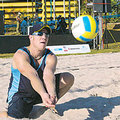 世界衛生組織表示,全球每年有6萬多人因過度暴曬在陽光的紫外線下而罹癌死亡,但只要透過簡單的預防措施,就可遠罹這種致命的疾病。
世界衛生組織表示,全球每年有6萬多人因過度暴曬在陽光的紫外線下而罹癌死亡,但只要透過簡單的預防措施,就可遠罹這種致命的疾病。
過度曝曬在紫外線下最嚴重的結果是罹患惡性黑色素瘤,這種癌症如果早期發現,治癒率相當高。據估計,全球因為黑色素瘤或其他皮膚相關癌症所造成的醫療負擔,90%以上都和紫外線曝曬有關。
世界衛生組織公共衛生與環境部門的主持人尼拉博士(Maria Neira)表示:「這項針對紫外線健康危害風險的全球性評估研究,目的是為大眾健康行動提供了良好的基礎。我們都需要陽光,但是太多陽光卻是危險──甚至致命的。」
世界衛生組織的新報告「全球因陽光紫外線而造成的疾病負擔」,是有史以來第一份針對紫外線帶來的健康負擔,所進行的全球性系統分析研究。該報告調查了9種因紫外線過度曝曬而有害健康的疾病。其中造成最重大疾病負擔的主要3種疾病,包括了皮膚惡性黑色素瘤、發生在不同皮膚細胞層的非黑色素瘤皮膚癌──鱗狀細胞癌,以及基底細胞癌(basal cell carcinomas)。
 此外,紫外線也造成另外3種眼疾──皮質性白內障(或說是眼球水晶體混濁)、角膜翼狀贅片(一種在眼睛表面長出的贅肉)、以及罕見的眼睛鱗狀細胞癌症。
此外,紫外線也造成另外3種眼疾──皮質性白內障(或說是眼球水晶體混濁)、角膜翼狀贅片(一種在眼睛表面長出的贅肉)、以及罕見的眼睛鱗狀細胞癌症。
尼拉博士表示,以下幾項簡易施行的安全陽光防曬措施就可以預防多數因為紫外線所造成的癌症及其疾病負擔:
- 限制正午時分在陽光下的曝曬時間
- 適度利用遮蔭:當紫外線最強時,尋找遮蔭
- 穿著可避免陽光曝曬的保護衣物,包括帽子和太陽眼鏡
- 使用防曬係數15以上的多用途防曬乳液
- 避免太陽燈和曬膚燈:界衛生組織建議18歲以下的年輕人完全不要使用這些裝置
- 熟悉紫外線指數:當紫外線指數預測輻射程度為3(中等)或以上時,應該做好防曬措施
- 保護幼童遠離陽光
Up to 60,000 cancer deaths a year worldwide are caused by too much exposure to ultraviolet radiation from the Sun, the World Health Organization says in a new report. Simple prevention measures can avert much of this illness and death, the world health agency advises.
The most serious consequence of excess ultraviolet radiation (UVR) is malignant melanoma, which has high cure rates only if detected early. Up to 90 percent of the global burden of disease from melanoma and other skin cancers are estimated to be due to UVR exposure.
"This global assessment of the health risks of UV radiation provides a good basis for public health action. We all need some sun, but too much sun can be dangerous - and even deadly," said Dr. Maria Neira, director for public health and the environment at the World Health Organization.
The new World Health Organization (WHO) report is the first-ever systematic examination of the global health burden due to ultraviolet radiation. The report, "Global Burden of Disease of Solar Ultraviolet Radiation," investigates nine adverse health outcomes from excess exposure to ultraviolet radiation. The main three, which cause the greatest burden of disease, are cutaneous malignant melanomas, and non-melanoma skin cancers developing in different cell layers of the skin - squamous cell carcinomas and basal cell carcinomas.
In addition, ultraviolet radiation causes three eye problems - cortical cataracts, or eye lens opacities; pterygium, a fleshy growth on the surface of the eye; and rare squamous cell carcinomas of the eye. The report notes that ultraviolet radiation does have beneficial effects, mainly in the production of vitamin D following skin exposure to the UVB, the shorter wavelength component of UVR. Adequate vitamin D prevents the development of bone diseases such as rickets, osteomalacia and osteoporosis.
In most cases minimal casual exposure to ultraviolet radiation should be sufficient to maintain vitamin D levels at a range that avoids these health problems. The dangers are much greater from over-exposure to the sun's radiation, the world health agency says.
A few easy-to-implement sun safety measures could prevent much of the cancer and other death and disease burden due to UV radiation, Dr. Neira says.
- Limit time in the midday sun.
- Use shade wisely: seek shade when UV rays are most intense.
- Wear protective clothing including hats and sunglasses.
- Use a broad-spectrum sunscreen of sun protection factor 15+.
- Avoid sunlamps and tanning parlours; for youth under the age of 18, WHO recommends that they do not use them at all.
- Know the UV index: when the UV Index predicts radiation levels of 3 (moderate) or above sun safety practices should be taken.
- Protect children from the sun.


